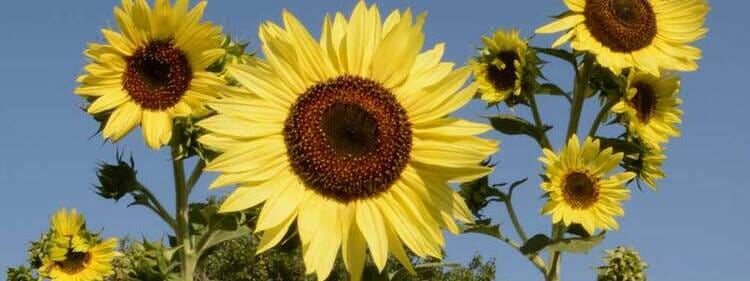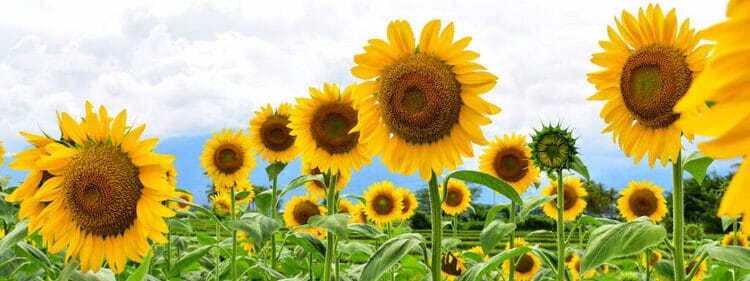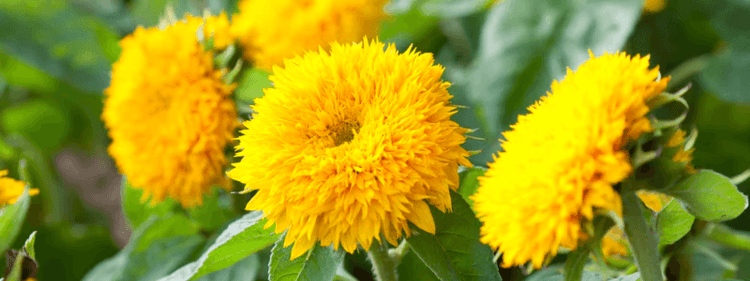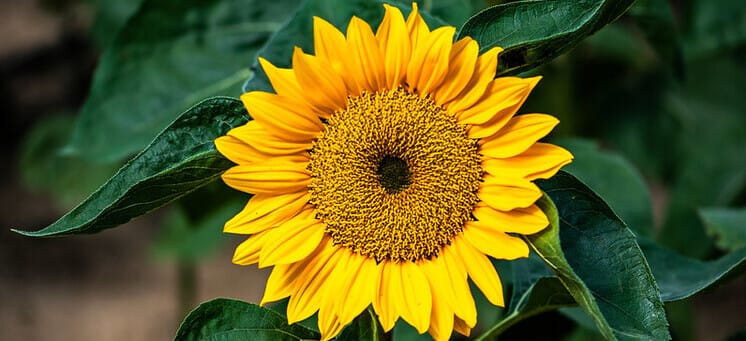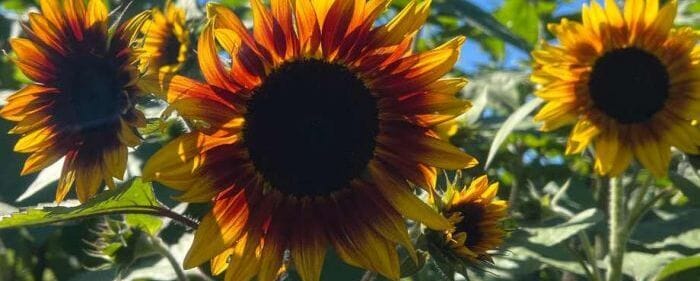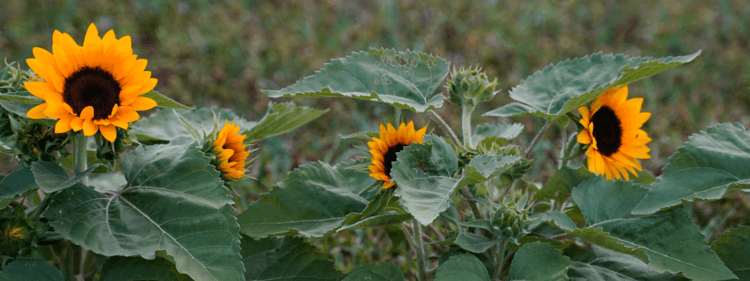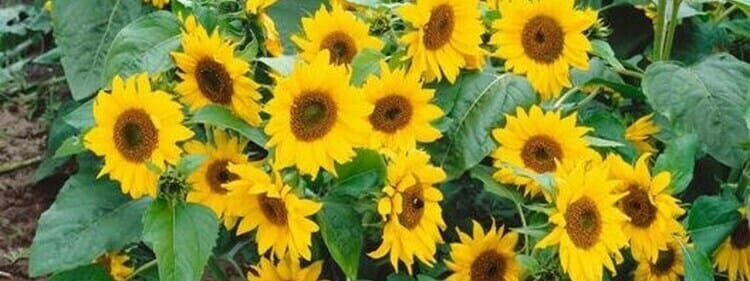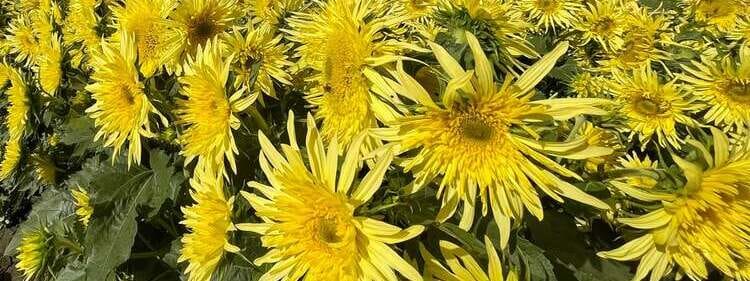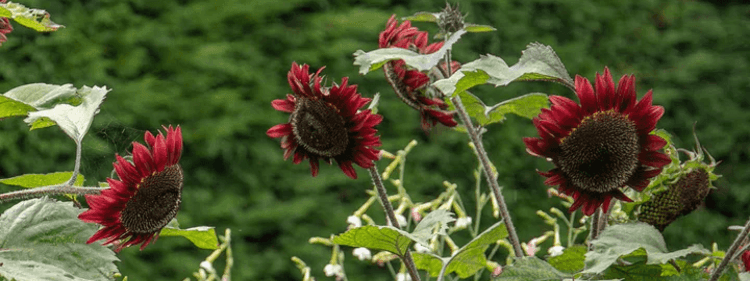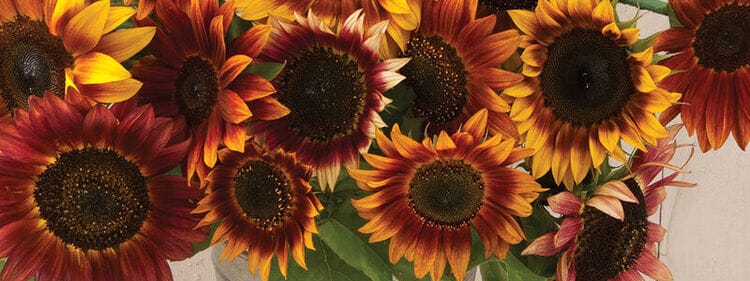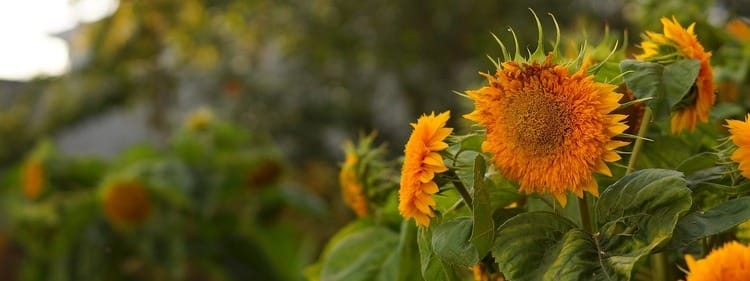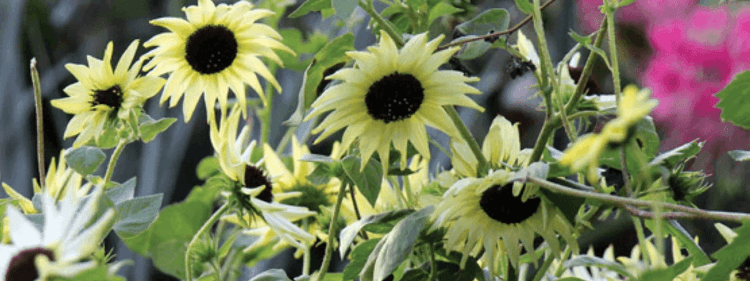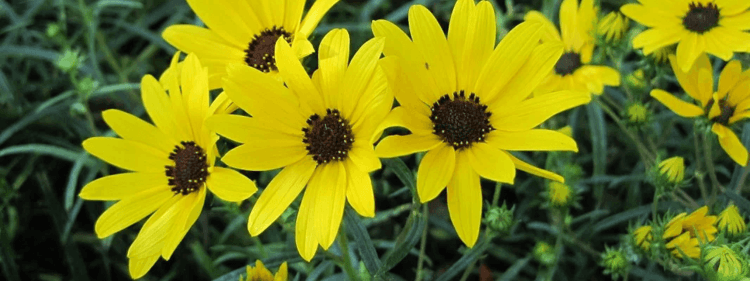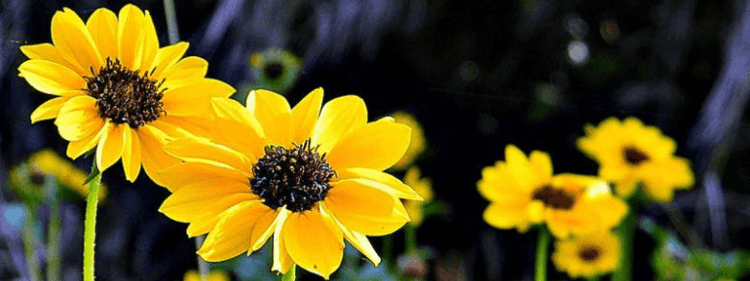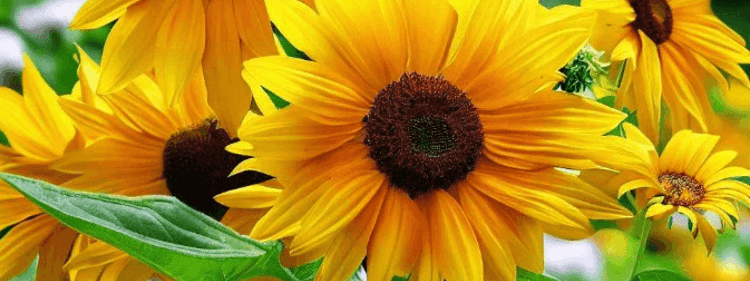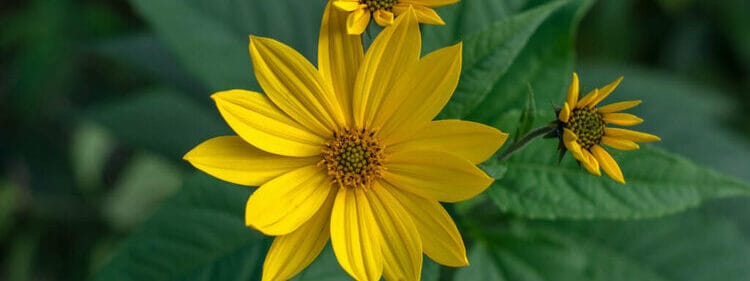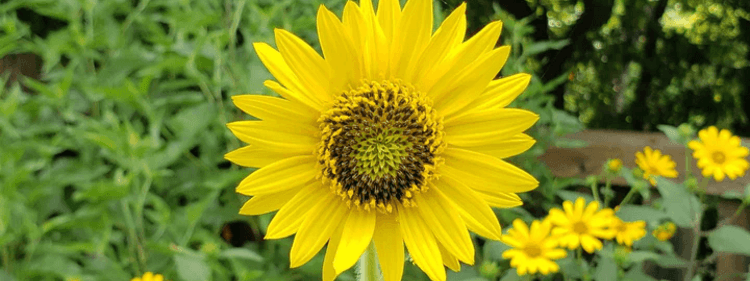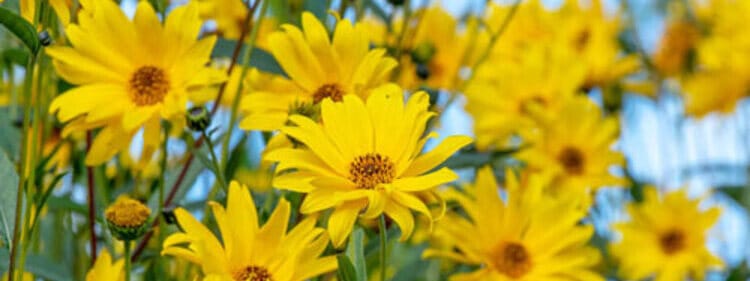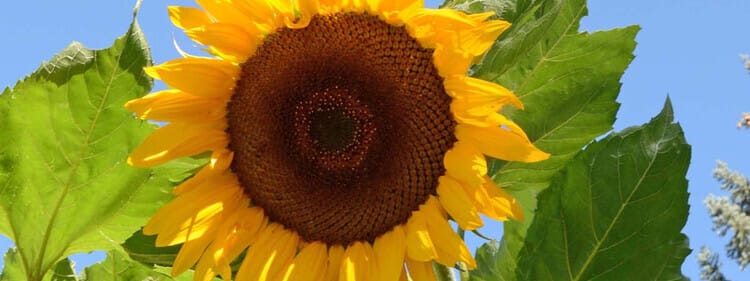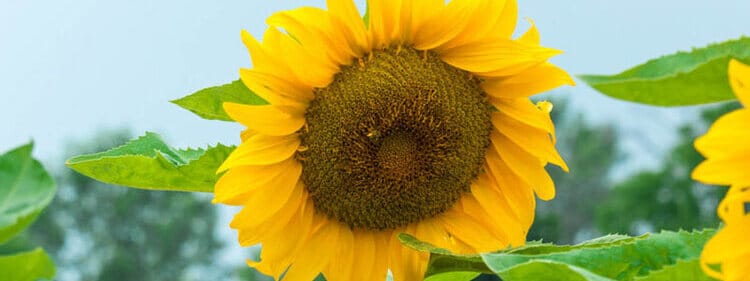People often see sunflowers as symbols of happiness, beauty, and hope. However, aside from serving decorative purposes, these wonderful blooms can also be a source of food. Their seeds can be eaten raw, dried, roasted, and even processed as oil. Indeed, sunflowers have many benefits and uses. So, it’s unsurprising that sunflower yields keep exceeding forecasted production harvest.
Another great thing about sunflowers is how well they resist pests and tolerate drought. Even homeowners can cultivate this plant in their backyard. So, if you’re wondering which sunflower varieties Australia gardens can grow, you’ve come to the right place. We’ll share the best types of yellow blooms you can cultivate.
Medium to Tall Sunflowers
Planting medium to tall sunflower varieties can give your garden a striking appeal. Imagine looking through your window and seeing bright, towering yellow blooms. Moreover, your yard will be the envy of your neighbours, since these flowers can grow as high as 16 feet. Here are some tall sunflower varieties you can plant:
1. Lemon Queen
Because they attract pollinators, Lemon Queen sunflowers are often cultivated by researchers to monitor honeybee populations. So, when you plant these lemon-yellow blooms, you’ll save the bees while boosting your garden’s appeal.
Lemon Queen sunflowers have branching clusters with four-to-six-inch blooms and chocolate brown centres. They can grow up to five or seven feet tall but take around 100 days to mature. However, if you’re patient, you’ll also harvest its edible buds.
Usually, the centre stalk of Lemon Queen sunflowers produces one main bloom. Eventually, the side shoots develop smaller blooms. Moreover, you can expect the plant to keep flowering until you enter the chilly season.
Plant successively every week or two if you want to have several blooms for floral arrangements. You can keep sowing until 12 weeks before the colder months.
Remember to protect your Lemon Queen sunflowers once they have started to germinate. To deter pests from messing up the plants, you should cover them with wire mesh or netting. This way, they won’t be able to come close to the sunflowers and eat them.
You should also know that the seeds in the flower’s centre can attract birds. So, while Lemon Queen sunflowers are low-maintenance, they usually require protection and attention. Despite that, you can expect them to tolerate some level of drought. You only need to water the plant once a week.
However, to ensure that your sunflowers will develop stronger roots, water deeply. This way, they can withstand strong winds and storms.
If you’re familiar with heliotropism, you’ll also find the Lemon Queen sunflower quite interesting. Its flower heads tend to turn towards the sun. So, don’t forget to choose an area that gets plenty of sunlight.
Usually, around 85 days, Lemon Queen sunflowers reach their full maturity. By then, you can harvest them and use them as cut blooms in floral arrangements.
2. ProCut Bicolour
If you want more depth and character in your yellow blooms, consider planting ProCut Bicolour sunflowers. They are pollenless hybrids that were developed for florists, which is also why they have the “pro” prefix.
If you’re looking for sunflower varieties for areas with a short growing season, consider cultivating ProCut Bicolours. They can start blooming 50 to 60 days after seeding.
However, what’s special about these blooms is their blazing sunset colours. Their three-toned flower heads can grow up to four inches wide. They will look striking when you plant them as borders for your garden. After all, they can grow as tall as six feet before they start blooming.
Don’t forget to stake the plant to support it as it grows. Moreover, before the buds open, you should pick them. You can keep the stalks from drooping if you place them in a deep vase.
3. Taiyo
While Taiyo originated from Japan, it is one of the most common sunflower varieties in Australia. What’s great about these yellow blooms is that it takes only around 14 weeks for them to mature. Moreover, they attract bees and butterflies efficiently. So, these flowers can bring you a beautiful garden show.
Every Taiyo stalk can produce a single flower head that can grow up to 10 inches wide. You’ll have dainty, yellow petals that surround a deep mahogany and orange centre.
Before Taiyo stalks start to produce blooms, they can reach up to five to seven feet high. Remember that they are among the sunflower varieties that can generate a lot of shade. So, if you’re planning to sow anything near it, make sure that the plant can tolerate shade.
Taiyo sunflowers are perfect as cut blooms. You can also plant them if you want flowers that attract pollinators. While planting a few stalks can be a lovely addition to a garden, a field of Taiyo sunflowers can be magnificent.
4. Skyscraper
When you want to fill your garden with towering masses of bright yellow blooms, you should plant Skyscraper sunflowers. Every stalk can reach up to 12 feet high, and it can produce multiple flowers. This plant is also among the sunflower varieties Australia gardeners cultivate when they want blooms that can mature within 75 days.
This plant produces dark green foliage along with flower heads that can grow as wide as 14 inches. Ensure you stake the sunflowers as they grow to prevent them from drooping. In most cases, they grow better beside a fence line or wall.
We recommend planting your Skyscraper sunflowers directly in the ground. Moreover, make sure that they get exposed to the sun throughout the day. Generally, skyscraper sunflowers require little maintenance.
5. Mammoth
Mammoth sunflowers can reach as high as 12 feet. So, if you want classic, towering blooms in your garden, then they’re perfect for you. However, remember that their flower heads can grow as wide as one foot. So, don’t get overwhelmed when they start blooming.
Farmers usually plant Mammoth sunflowers to harvest their seeds for oil. While they are best grown in fields, their gigantic appeal can still be perfect for bigger backyards.
Make sure you plant your Mammoth sunflowers as soon as the weather becomes warmer. Remember that cold temperatures can harm their tender seedlings. If you plant them too late and the weather gets colder, they might not reach their optimal mature height.
6. American Giant Hybrid
One of the sunflower varieties in Australia that is sure to impress is the American Giant Hybrid sunflower. It produces supersized flower heads and grows up to 17 feet tall. What you’ll like about this massive plant is it doesn’t easily fold in windy conditions. After all, it has a robust, thick stalk that keeps it standing.
If you’re planting American Giant Hybrid sunflowers in your garden, use them to create borders or hedges. After all, they can efficiently provide a windbreak for your more fragile plants.
Because these sunflowers have large heads that can grow as wide as a foot, they effectively attract pollinators and even birds. So, with the American Giant Hybrid sunflower, your garden will soon become your neighbours’ envy.
You can directly seed or transplant this sunflower variety. Moreover, we recommend planting it on drip irrigation. Make sure you bury the drip tape about four inches below the soil. You should also plant directly above the tape.
Dwarf Sunflowers
If you have limited space in your garden, you can plant dwarf sunflower varieties. The tallest they can get is about three feet. So, even if you don’t have a backyard, you can grow them in pots and window boxes.
7. Teddy Bear
Teddy Bear sunflowers got their name for their cute, fluffy heads. They’re made of so much fluff that their centre disc florets are not as noticeable as what common sunflowers have. While giant sunflowers can grow up to 14 feet tall, the Teddy Bear sunflower is a dwarf variety with an average height of four feet. Moreover, their flower heads can grow as wide as five inches, producing fluffy, double petals.
Teddy Bear sunflowers are not great as cut flowers. However, they may nice decorations for flower beds and smaller gardens. Besides, they are among the open-pollinated heirloom sunflower varieties in Australia. So, they attract butterflies and bees.
Remember to plant your Teddy Bear sunflowers under direct sunlight. However, you should keep them from drying out. As such, make sure that the soil is always moist. While they need frequent watering, these flowers shouldn’t be in waterlogged soil.
8. Double Dandy
Unlike the common sunflower varieties Australia gardeners plant, the Double Dandy does not have yellow blooms. However, its colour can give character to your backyard. It has purple to burgundy, double-ruffled petals with cream tips. Double Dandy sunflowers are generally considered flowering annual plants no matter where you live.
This sunflower variety can grow around a foot tall with flower heads that can be 18 inches in diameter. If you want to add an accent colour to a bed of yellow blooms, consider planting Double Dandies. Besides, they look great in a sunflower bouquet.
9. Elf Sunflower
If you like seeing butterflies in your garden, plant Elf sunflowers. This variety attracts pollinators, so you can expect a beautiful butterfly show when you have it around. Growing around a foot tall, the Elf sunflower is the shortest among the dwarf varieties. Moreover, its showy flower head can grow up to six inches wide.
When incorporated in Alkaline solutions, this sunflower variety can produce a bright yellow dye. Using sunflowers as a dye is not uncommon. After all, native Americans have been using sunflower seeds to produce a dark purple dye for baskets.
When planting Elf sunflowers, make sure that you sow the seeds directly on the ground. They have to be at least six inches apart. Moreover, don’t forget to water the soil after planting. After 60 days, you can expect your Elf sunflowers to reach full maturity.
10. Firecracker
The Firecracker sunflower is considered to be a semi-dwarf variety. It can grow up to three feet tall with heads that can be around eight inches wide. You’ll find its firework-resembling head to be quite interesting.
Because of its gradient of chocolate brown to yellow petals, it looks like a firecracker bursting in the sky. While it is one of the smaller sunflower varieties Australia gardens grow, it can easily stand out because of its distinct appearance. Moreover, their unique beauty makes them great as anniversary presents.
When planting Firecracker sunflowers, make sure to use humus-rich, neutral to alkaline soil. Also, keep the soil moderately fertile and moist.
As the stalks grow taller, you should support them with stakes. Heavy wind can easily topple them because of the weight of their sunflower heads. As such, you should choose a sheltered location that still gets a lot of sun exposure.
Firecrackers are among the bush sunflower varieties. You can expect yours to produce several branches and flowers when you plant them directly in the ground. However, if you opt for a small pot, yours would produce a single flower.
11. Sunspot
Sunspot sunflowers are cultivar varieties that have heads that can grow as wide as two feet. So, it’s not surprising that they attract bees and other pollinators. Moreover, they have strong stalks that can grow as tall as two feet.
If you’re not using chemical sprays, you can add the petals to your salads. However, like dandelion greens, they can be quite bitter. So, they’re best as a pretty garnish for ice creams and cakes.
Sunspot sunflowers thrive as container plants. However, they’ll also look great when you plant them as low-lying blooms along pathways.
Around four to six weeks before the last frost, you can start cultivating Sunspot sunflowers indoors. Don’t forget to mix compost into the soil to avoid producing more foliage than flowers. Use paper pots to avoid stressing their roots when you transplant the flowers. Moreover, water the seedlings regularly until their stalks seem stronger.
12. Junior Sunflower
Junior sunflowers are the miniature version of the common sunflower familiar to most people. You’ll rarely find them getting over knee high, making them great as front-row blooms in a garden. Moreover, because they are pollenless, they are perfect as cut flowers for dining or coffee tables.
Once it gets warmer, you can start planting the seeds directly in the ground. However, if you want to start early, you can do so three weeks before planting out. Make sure to use peat pots for your seedlings. Also, choose a location where the plant can get full sun exposure.
What’s great about Junior sunflowers is how fast they mature. It only takes about 55 days for them to reach full bloom. You don’t even have to fertilise them because they grow easily. However, we still recommend using slow-release granular when you think your soil quality is poor.
13. Topolino
Topolino is another mini sunflower cultivar with deep yellow petals and a brown centre. Aside from being a dwarf sunflower, this variety also has a branching growth habit. Moreover, you can expect it to keep blooming with multiple flower heads all summer-long.
While Topolino sunflowers are commonly planted in tubs and containers, they thrive better when they are planted directly in the soil. For instance, you can use them as a mini flower hedge. After all, they only grow up to 16 inches tall. Moreover, they look great in small vases like the sunflower in our Native Wonder Mason Jar arrangement.
Topolino sunflowers are perfect for filling annual beds because of their branching growth habit. When planting them, make sure to use soil that is rich in nutrients. Moreover, you should choose a location that gets a lot of sun. When you plant outdoors from April to early June, you can expect them to start blooming between July and September.
14. Sundance Kid
Many believe that Sundance Kid sunflowers may be the oldest dwarf variety. It has orange to yellow, semi-double petals and a dark brown centre. Moreover, this perennial and annual plant usually grows up to 16 inches tall with flower heads that can be around 14 to 18 inches wide. As such, they are ideal for brightening the borders of a garden or adding a colourful accent to smaller bouquets.
What’s even more likeable about Sundance Kid sunflowers is they are extremely simple to grow. Compared to common sunflower varieties in Australia, this plant continues to produce blooms longer. So, you can enjoy their beauty for an extended period.
However, you should know that Sundance Kid sunflowers require a lot of water. If you don’t water them enough, they might drain the moisture of their surrounding soil. Consequently, they might dry out nearby plants. So, we recommend keeping a good distance between your other plants and your Sundance Kid sunflowers. Of course, don’t forget to water your yellow blooms regularly to prevent them from draining the moisture off their surrounding soil.
15. Lemon Cutie
There are many wonderful reasons why the Lemon Cutie sunflower won Fleuroselect’s 2023 Gold Medal for Novelty. This dwarf sunflower variety only grows about a foot tall and reaches maturity after about 55 days.
If you want to attract pollinators like bees and butterflies, you will benefit from planting Lemon Cutie sunflowers. While these blooms are pollenless, they produce nectar that is quite appealing for pollinating insects.
Whether you plant them in containers or directly in the ground, they will stay beautiful and fresh for a long time. Even without using growth retardants, Lemon Cutie sunflowers are easy to cultivate. They can easily be a showstopper, especially because of their bright-yellow flower heads. Moreover, because they have a branching growth habit, they can easily blanket your garden.
Branching Sunflowers
Sunflower varieties with a branching growth habit have a main stem that produces several side stems. Every stem usually has one flower. So, branching sunflowers tend to produce blooms for a longer period.
Unlike tall sunflowers that grow upward, branching varieties typically grow outward. So, you’ll need a bigger space if you decide to cultivate them. Moreover, most of them grow about five feet tall, but there are quite a few dwarf varieties under this category.
16. Moulin Rouge
Also known as Rouge Royal, Moulin Rouge is a hybrid sunflower variety with a branching growth habit. Plant it if you want a dramatic accent in your garden bed or your cut flowers. After all, this pollenless plant produces burgundy red flowers that can grow as wide as six inches.
If you’re planning to use your Rouge Royals as cut flowers, make sure to plant them close together. This way, they will have longer stems and smaller blooms. Moreover, harvest the flowers before they are completely open to prolong their vase life.
You can also use the petals as salad toppers. They will add a bittersweet flavour to your greens and even delight you with a pop of colour. Moreover, you can eat the young sunflower buds which have a similar texture and taste to artichoke hearts. Marinate, grill, or sautee them and use them as an appetizer or a side dish
17. Autumn Beauty
If you want the colours of fall in your garden as early as summer, then you should plant Autumn Beauty sunflowers. They are perfect for gardeners who want variety in their lives, especially since the petals come in a mixture of warm reds, oranges and yellows.
Autumn Beauty sunflowers are open-pollinated plants that have sturdy stems, allowing them to grow up to 80 inches tall. Moreover, their four to eight-inch, nectar-rich blooms attract butterflies and small birds.
If you’re an impatient gardener, the Autumn Beauty sunflower may be a good choice for you. After all, this plant reaches its full maturity 60 days after sowing. Besides, in a single seed pack, you can produce a variety of interesting fall colours.
18. Chocolate Sunflower
Chocolate sunflowers may look deliciously appealing to the eyes, but they’re not sweet to eat. While their buds and petals are edible, they have a nutty and slightly bitter taste. So, they’re better off as salad or soup toppers.
However, if you want to add depth to the colours you see in your garden, planting Chocolate sunflowers may be a good idea. Their beautiful blooms come in shades of dark burgundy, maroon, and cocoa brown.
Note that Chocolate sunflowers can grow as tall as five feet, and their blooms can be as wide as six inches. So, if you want dainty, delicate flowers for your garden, they may not be the best choice for you. However, if you want striking blooms that can easily turn heads, you should plant this sunflower variety. They also look great as accents for lighter-coloured blooms like the Italian White.
19. Goldy Honey Bear
Goldy Honey Bear sunflowers look a lot like the Teddy Bear variety. However, while the latter is a much smaller plant, the former’s fluffy flowers sit on top of much taller stalks. Goldy Honey Bear sunflowers can grow as tall as six feet, and their pom-pom heads can be as wide as seven inches. Their rich, golden colour makes it seem like you’ve captured stunning rays of sunshine in your garden.
The centres of Goldy Honey Bear sunflowers start as light green. However, as they mature, that green colour begins to turn brown. Moreover, you don’t have to install support for the stalks because they are strong enough to withstand windy conditions.
Once your Goldy Honey Bear sunflowers have reached maturity, you can harvest them and place them in a basic vase. They will look stunning even without filler foliage. They can easily break the monotony in a white room.
20. Italian White
Do you prefer the large bloom size of giant sunflowers? Perhaps, you like the floriferous growth habit of the smaller varieties. Well, you’ll get all those from the elegant Italian White sunflower.
This variety has blooms that grow four inches wide. Its deep brown centre is adorned by ruffled, yellow-to-white petals. Moreover, this branching plant has sturdy stalks that can grow up to seven feet tall. Besides, it’s perfect for gardeners who want to have wonderful blooms for a longer period. After all, this variety produces several flowers over a long season.
Italian White sunflowers are the ideal size for border ends. However, they also look great as stand-alone windbreakers or hedges. Moreover, if you have a sunny garden, you can easily grow them. Once the weather becomes warmer, you can directly sow your seeds. You don’t even have to worry too much about the kind of soil you use. Just make sure that you plant them at least two feet apart. This way, they have enough room to show off their foliage as they mature.
Perennial Sunflowers
Most sunflower varieties in Australia are annual plants that thrive when they are planted in spring. However, there are also perennial sunflowers that can live for several years. You’d notice that they have smaller flower heads than common varieties. Moreover, as they approach the autumn season, their foliage dies. Even so, their roots continue to live, sprouting the plant back to life every spring. Here are some of the perennial sunflower varieties you can plant:
21. Swamp Sunflower
Also known as the Narrowleaf sunflower, Swamp sunflowers have small blooms with radially symmetrical petals. They got their name because they naturally sprout in wet flatwoods, marshes and even ditches beside roads. This variety is a short-lived perennial that usually blooms throughout the fall season. Moreover, they have a habit of forming dense shrubs, which make them look like stunning swaths of yellow sunbursts.
If you’re planning to cultivate swamp sunflowers in your garden, choose a location that gets plenty of sunlight. They can still survive under partial shade, but don’t forget to pinch them to encourage branching. Moreover, you should choose dry to wet soils or soils with some clay.
You can either plant your Swamp sunflowers as borders or even as edging for your perennial bed. Remember that this variety tends to be floriferous, filling the space around it. So, you may have to prune yours from time to time to keep it tidy. Moreover, you can plant them by your fence so that the structure can act as support for the flowers.
When sowing Swamp sunflower seeds, make sure that they are around two feet apart. This way, you can give them space to spread. After all, they quickly spread through their underground stems.
22. Beach Sunflower
If you live in a coastal area, you can plant Beach sunflowers. This perennial variety can tolerate salt in the atmosphere. Moreover, it can survive without regular watering, blooming from spring to autumn. Gardeners usually cultivate it to add a colourful ground cover, especially since this plant has a spreading growth habit. Moreover, its trailing behaviour makes it perfect as plants that cascade down trellis, walls, or planters.
You can use cuttings or seeds to start your Beach sunflower patch. Of course, don’t forget to choose a sunny location, ideally with well-draining or sandy soil. As we’ve mentioned, this plant can survive even under high levels of salt spray. So, it’s perfect for gardens or yards close to the sea.
Once your Beach sunflowers are established, they will survive even with little to no irrigation. Remember that the plant may begin to decline with over-irrigation. Moreover, it might start developing sunflower rust, a defoliating disease. On the other hand, with the ideal watering amount and frequency, the plant will quickly spread and thrive.
23. Maximillian Sunflower
The Maximilian sunflower is an herbaceous prairie perennial that is usually eaten by livestock. Also known as the Michaelmas Daisy, this plant has several leafy, tall, and unbranched stems that can grow up to 10 feet. Its hairy, coarse, and greyish-green leaves typically fold lengthwise. Moreover, its bright yellow blooms can grow up to three inches wide. You’ll usually find them in dry prairies and rocky slopes that are exposed to the full sun.
Aside from being livestock food, the Maximilian sunflower also produces seeds that other forms of wildlife eat. One interesting fact about this plant is that it was named after German naturalist and explorer Prince Maximilian. In the 1800s, he led an expedition in North America, during which he encountered the perennial sunflower.
The Maximilian sunflower grows best in clay-like, moist soil. If you’re planting indoors, you should start five weeks before the evening temperatures are around 10C (50F). Once the seedlings are around two inches tall, you can transplant them into your garden soil. Make sure that each seedling is at least a foot apart.
On the other hand, if you’re planting outdoors, prepare a seed bed. You don’t have to sow too deep—an eighth of an inch will do. If you start planting late in the fall, the plant will germinate in the spring naturally.
24. Jerusalem Artichoke
Don’t be confused—the Jerusalem Artichoke sunflower is neither from Jerusalem nor is it an artichoke. Instead, it’s a wild perennial plant that commonly grows in central United States. Also known as the Sunchoke, this plant was widely cultivated and traded by Native Americans for its tuber.
The Jerusalem Artichoke sunflower can also be invasive because it easily spreads. The University of Wisconsin-Extension also reported that you could get up to six pounds of tubers from a single sunchoke plant. Moreover, every stalk will produce new plants the following season.
Aside from producing wonderful yellow blooms, Sunchokes can also prevent weeds from growing. Because their stems and leaves are allelopathic, they produce phytotoxins that keep certain plant species from germinating.
25. Ashy Sunflower
Also referred to as the Downy sunflower or the Hairy sunflower, the Ashy sunflower is a perennial plant that usually grows up to four feet tall. Moreover, you’ll typically find them growing wildly along roadsides, rocky glades, dry prairies, and fields.
The reason behind this plant’s common name is its greyish foliage colour. Its stems produce with broad oval leaves that typically grow up to six inches long. Meanwhile, the upper stems develop flowers with sizes that can be up to four inches in diameter. Every flower head has a tiny disk floret that can produce up to 30 yellow petals.
If you’re planning to cultivate this plant, use well-draining soil and choose a sunny location. The Ashy sunflower can tolerate some shade, but they thrive under the full sun. Moreover, keep it from spreading into broad clumps. Otherwise, you will have a difficult time maintaining the sunflowers properly.
You should also select a planting site that is protected from strong winds, especially since the Ashy sunflower’s stalks aren’t reliably sturdy. As the summer progresses, you’ll notice its foliage starting to depreciate. When this happens, make sure you get rid of the tattered and browned seed heads. Moreover, consider keeping the seed heads and using them as bird feed.
26. Willow-Leaved Sunflower
The Willow-Leaved sunflower is a floriferous perennial plant that usually grows in clumps. It has upright stems with willow-like, arching, and narrow leaves that can grow up to seven inches long. Throughout the end of the summer and fall, you can see it producing showy sprays of brilliant yellow flowers. Each tiny flower has a dark brown centre adorned by bright yellow petals.
If you want to attract pollinators like butterflies, consider planting Willow-Leaved sunflowers. Moreover, they can be a great addition to the front of the border, especially since they profusely produce bright blooms. Besides, you don’t need to stake the plant if it grows.
When planting Willow-Leaved sunflowers, you’ll need medium moisture, well-draining soils. Also, don’t forget to choose a sunny spot for the plant. Once you’ve established the right growing conditions for your Willow-Leaved sunflowers, they won’t require too much maintenance. However, make sure to get rid of old stems with dying blooms.
27. Thinleaf Sunflower
Also known as the Forest sunflower, the Thinleaf Sunflower is an herbaceous perennial plant that is native to central and eastern North America. It has numerous thin, upright-growing stems that produce multiple flowers. Moreover, Thinleaf sunflowers typically grow up to two feet, but other varieties can reach up to six feet.
Thinleaf sunflowers are high-value plants that serve as a food source for birds, pollinators, and other animals. When planted in a partially shaded area, they spread quickly. Besides, they self-seed and creep rhizomes to form colonies.
Make sure to use rich loamy soil when planting Thinleaf sunflowers. Because they are low-maintenance, they are perfect for cottage gardens that do not require too much care. You’ll also love how this plant rarely attracts pests or develop diseases. However, it might suffer from powdery mildew when it doesn’t get enough water. Also, cut a third of its height in early summer to encourage bushier growth before its blooming season.
Sunflowers for Eating
Open-pollinated sunflower varieties have seeds that humans and birds can eat. However, you’ll discover that certain cultivars have more meaty seeds. Some of them are taller sunflowers that can tower over your garden, with heads that can grow bigger than a foot in diameter. Here are some of the best sunflower varieties that you can plant and harvest for seeds:
28. Mammoth Grey Stripe
It makes sense to describe this sunflower variety as a “mammoth” because it can grow up to 12 feet tall. Besides, every flower head it produces can be as wide as 13 inches in diameter. Moreover, the Mammoth Grey Stripe sunflower is an open-pollinated plant. So, you can attract buzzing bees and beautiful butterflies when you have them in your garden.
If you want to plant Mammoth Grey Stripe sunflowers, you must choose a location that gets plenty of sunlight. Also, you should keep it away from other plants that need pesticides. While this towering plant grows, don’t forget to use bamboo stakes or a fence to support it. Moreover, give each plant at least three feet of space to give it enough room to grow.
While Mammoth Grey Stripe sunflowers look stunning in full maturity, you’ll have to be patient. It takes around 110 days for the plant to start blooming. However, it is worth every resource and effort you invest. Usually, their blooms can last for over a month before they begin drooping. When this happens, it means you’re going to harvest soon.
When they’re ready, the flower heads can give you over 100 seeds. However, if you don’t want squirrels or birds stealing the seeds, remember to use netting to cover the mature heads.
29. Mongolian Giant
The head of a Mongolian Giant sunflower can be as big as an extra-large pizza. So, you can just imagine how tall this variety can grow. Every stalk can be as high as 14 feet, producing a single flower that can grow up to 18 inches in diameter.
However, you must be patient if you want to plant Mongolian Giant sunflowers. They take around 90 days to reach full maturity. Once they start blooming, the bright yellow heads can last for up to six weeks. They will start dropping their petals, forming giant seeds that birds and humans alike can eat.
If you have kids, planting a Mongolian Giant can be a fund project that you can do together. Everyone will find the activity interesting, especially during the growing season peak. You’ll notice that the stalk grows taller by an inch each day.
Farmers usually make a living out of growing Mongolian Giant sunflowers. However, if you’re planting them for fun, you can turn the seeds into snacks. After all, there are plenty of delicious sunflower seeds recipes online.
30. Super Snack Sunflower
Perhaps, you’re not ready to plant giant sunflower varieties, but you still want to harvest sunflower seeds. Well, the Super Snack sunflower may be the perfect plant for you. It is a hybrid that can grow around five feet tall. Unlike other varieties under this category, the Super Snack sunflower only takes about 70 days to bloom.
Every stem produces a single bloom that resembles Mongolian Giant sunflowers. However, the heads of Super Snack sunflowers only grow about ten inches wide. Even so, they still produce meaty seeds that birds and humans alike can enjoy. Six weeks after the plant blooms, the seeds will be ripe for harvest.
Aside from being a source of food, this variety also looks great as a cut flower. If you plant Super Snack sunflowers along the borders of your garden, they will also act as a privacy screen.
Reasons to Grow Sunflowers in Your Garden
Are you still on the fence about planting sunflowers in your garden? Well, did you know that aside from being stunning cut flowers, these plants can also bring several ecological benefits? Besides, their seeds can also be a good source of vitamins. So, if you still aren’t convinced, check out the following reasons why you should start growing sunflowers in your garden:
More pollinators in your garden
Research from the University of British Columbia found that the sunflowers’ invisible UV colours attract pollinators like bees. Moreover, these bees can sense the faint electric fields around the petals.
Because some sunflowers can grow as tall as ten feet with heads as wide as 12 inches, they act like towering beacons that attract bees. So, if you’re also fond of growing shrubs, vegetables, and fruit trees, planting sunflowers can attract more pollinators to your garden.
Vitamin-rich, meaty sunflower seeds
There are many reasons why sunflower seeds are considered a superfood. Aside from being loaded with healthy plant fats and fibre, they are also rich in vitamins, including B3, B5, B6, B9, and E. Besides, these seeds are a great source of manganese, selenium and copper.
Of course, you can easily buy sunflower seeds at the supermarket. However, you’re uncertain how these seeds were cultivated. On the other hand, if you plant your own sunflowers organically, you’ll have a healthy snack that is free from fungicides, herbicides, and pesticides.
No weeds in your garden
Because sunflowers are allelopathic, they prevent weeds from growing around them. If you have a bigger garden, having them can be beneficial for your other plants. Just make sure that you give enough space between your sunflowers and other plants. This way, your bright yellow blooms won’t cause harm to them.
Frequently Asked Questions about Sunflower Varieties
Q: How many varieties of sunflowers are there?
There are over 70 sunflower varieties across the globe today. Classified under the Helianthus species, these flowers are known to be heliotropic. Throughout the day, they move around so that their heads would always face the sun.
Q: What are the 7 classifications of a sunflower?
Here is the sunflower’s taxonomic hierarchy:
Kingdom – Plantae
Division/Phylum – Tracheophyta
Subdivision – Spermatophyta
Class – Magnoliopsida
Order – Asterales
Family – Asteraceae
Genus – Helianthus
Species - Annus
Q: What are the most common types of sunflowers?
The most commonly cultivated sunflower varieties include the following:
Dwarf – Teddy Bear, Sunspot and Topolino
Medium to tall – ProCut Bicolor, Mammoth and American Giant
Branching – Goldy Honey Bear, Chocolate, Autumn Beauty and Italian White
Q: Which are some hybrid varieties of sunflower?
Some examples of sunflower hybrid varieties include the Moulin Rouge, Earthwalker, Key Lime Pie, and Bicentenary.
Q: What is the shortest variety of sunflower?
Dwarf sunflowers usually don’t grow beyond three feet tall. Some examples of dwarf varieties include the Teddy Bear, Topolino, Sundance Kid and Double Dandy.
Q: What is the biggest sunflower variety?
The tallest sunflower varieties include the Mammoth, Original Sun, Titan and California Graystripe. These plants can grow around 10 feet tall. Meanwhile, the sunflower holding the world record for the tallest height is the one which was grown by German gardener Hans-Peter Schiffer. In 2014, his sunflower measured 30 feet and an inch tall.
Q: What is the largest sunflower seed variety?
The largest sunflower seed variety, which comes from the Mongolian Giant, can measure about an inch and a half long.
Get Your Bright Sunflowers from Flowers Across Brisbane
While sunflowers can be a stunning addition to your garden, you’ll need a lot of patience growing them. After all, most of them take 60 to 90 days to mature.
So, if you need beautiful yellow sunflowers right now, turn to Flowers Across Brisbane. We have a wide collection of sunflower arrangements that are sure to brighten your day. For instance, our Pocket Full of Sunshine bunch comes with yellow blooms that can easily boost your mood.
The best part about our sunflower collection is that you can have yours delivered right to your doorstep. If you order before 2PM, you can even get your wonderful blooms the same day.
To get your sunflowers delivered today, contact Flowers Across Brisbane.
